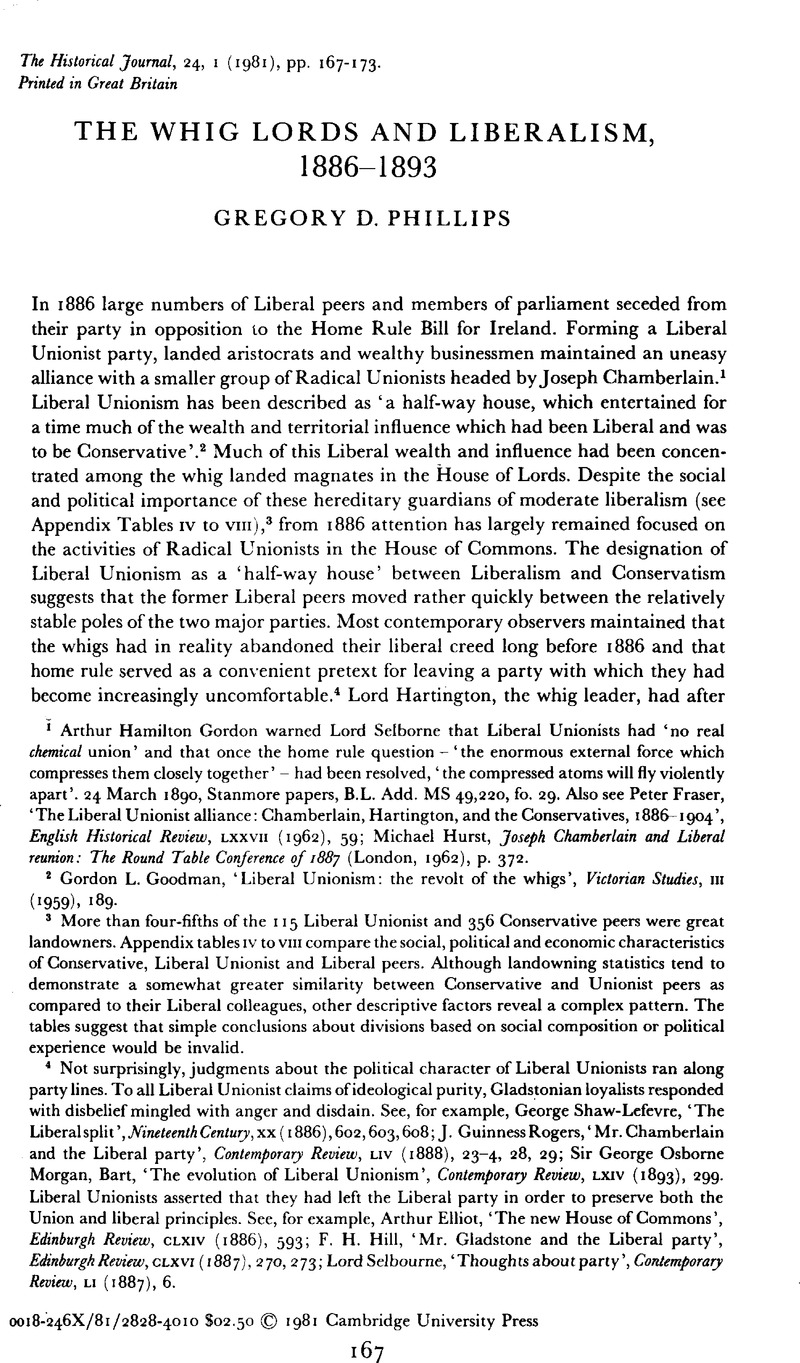Published online by Cambridge University Press: 11 February 2009

1 Arthur Hamilton Gordon warned Lord Selborne that Liberal Unionists had ‘no real chemical union’ and that once the home rule question - ‘the enormous external force which compresses them closely together’ - had been resolved, ‘the compressed atoms will fly violently apart’. 24 March 1890, Stanmore papers, B.L. Add. MS 49,220, fo. 29. Also see Fraser, Peter, ‘The Liberal Unionist alliance: Chamberlain, Hartington, and the Conservatives, 1886–1904’, English Historical Review, LXXVII (1962), 59CrossRefGoogle Scholar; Hurst, Michael, Joseph Chamberlain and Liberal reunion: The Round Table Conference of I887 (London, 1962), p. 372.Google Scholar
2 Goodman, n L., ‘Liberal Unionism: the revolt of the whigs’, Victorian Studies, III (1959). 189.Google Scholar
3 More than four-fifths of the 115 Liberal Unionist and 356 Conservative peers were great landowners. Appendix tables IV to VIII compare the social, political and economic characteristics of Conservative, Liberal Unionist and Liberal peers. Although landowning statistics tend to demonstrate a somewhat greater similarity between Conservative and Unionist peers as compared to their Liberal colleagues, other descriptive factors reveal a complex pattern. The tables suggest that simple conclusions about divisions based on social composition or political experience would be invalid.
4 Not surprisingly, judgments about the political character of Liberal Unionists ran along party lines. To all Liberal Unionist claims of ideological purity, Gladstonian loyalists responded with disbelief mingled with anger and disdain. See, for example, George, Shaw-Lefevre, ‘The Liberal spin’, Nineteenth Century, xx (1886), 602, 603, 608Google Scholar; Rogers, J. Guinness, ‘Mr. Chamberlain and the Liberal party’, Contemporary Review, LIV (1888), 23–4, 28, 29Google Scholar; Morgan, Sir George Osborne, Bart, , ‘The evolution of Liberal Unionism’, Contemporary Review, LXIV (1893), 299Google Scholar. Liberal Unionists asserted that they had left the Liberal party in order to preserve both the Union and liberal principles. See, for example, Elliot, Arthur, ‘The new House of Commons’, Edinburgh Review, CLXIV (1886), 593Google Scholar; Hill, F. H., ‘Mr. Gladstone and the Liberal party’, Edinburgh Review, CLXVI (1887), 270, 273Google Scholar; Selbourne, Lord, ‘Thoughts about party’, Contemporary Review, LI (1887), 6.Google Scholar
5 Fitzmaurice, d Edmond, The life of Granville George Leveson Gower, second earl Granville, K.G., 1815–1891, (London, 1905), II, 464.Google Scholar
6 See, for example, Goodman, , ‘Liberal Unionism’, p. 184, and the same author's ‘The Liberal Unionist party, 1886–1895’, unpublished doctoral dissertation, University of Chicago, 1956Google Scholar; Hurst, , Liberal reunion, pp. 1–6Google Scholar; Shannon, Richard, The crisis of imperialism, 1865–1915 (1976), p. 237Google Scholar; and Southgate, Donald, The passing of the whigs, 1832–1886 (London, 1962), pp. 372, 416Google Scholar. F. J. C. Hearnshaw has noted, however, that, ‘Even Hartington, the most conservative of the whigs... differed from Salisbury in his attitude to the church, the constitution, the crown, the land, and education. Conservatism in England: an analytical, historical, and political survey (New York, 1967), pp. 237–8.Google Scholar
7 Hansard, 337 H. of L. Deb., col. 645–9 (25 June 1889).
8 Peter, Davis, ‘The Liberal Unionist party and the Irish policy of Lord Salisbury's government, 1886–1892’, The Historical Journal, XVIII (1975), 85–104. Davis emphasizes the role of the Radical Unionists in the House of Commons.Google Scholar
9 Gathorne-Hardy, d E., Gathorne Hardy, first earl of Cranbrook: a memoir (London, 1910), 11, 285–6.Google Scholar
10 Hansard, 319 H. of L. Deb., col. 17 (11 August 1887).
11 Hansard, 336 H. of L. Deb., col. 485 (20 May 1889).
12 Hansard, 351 H. of L. Deb., col. 6–7 (3 March 1891).
13 Hansard, 347 H. of L. Deb., col. 1846–50 (5 August 1890).
14 Peter, Fraser, Joseph Chamberlain: radicalism and empire, 1868–1914 (London, 1966), p. 110Google Scholar. Also see Holland, Bernard, The life of Spencer Compton, eighth duke of Devonshire (London, 1911) 11, 169ff.Google Scholar
15 Cooke, A. B. and John, Vincent, The governing passion: cabinet government and party politics in Britain, 1885–86 (Brighton, 1974), pp. 126–31.Google Scholar
16 Bernard, Mallett, Thomas George, earl of Northbrook, G. C.S.I.: a memoir (London, 1908), p. 240.Google Scholar
17 For an extensive analysis, see Paul, Smith, Disraelian Conservatism and social reform I (London, 1967).Google Scholar
18 Ensor, R. C. K., ‘Some political and economic interactions in later Victorian England’, Transactions of the Royal Historical Society, 4th series, XXXI (1949), 18–19Google Scholar; Philip, Magnus, Gladstone: a biography (New York, 1964), pp. 394–5Google Scholar; Clarke, P. F., ‘Electoral sociology of y_ modern Britain’, History, LVII (1972), 31–55CrossRefGoogle Scholar; Cornford, J., ‘The transformation of Conservatism i in the late nineteenth century’, Victorian Studies, VII (1963–1964), 35–66.Google Scholar
19 The seven divisions involved the Endowed Schools Acts, the standing orders of the House of Lords and land transfer legislation.